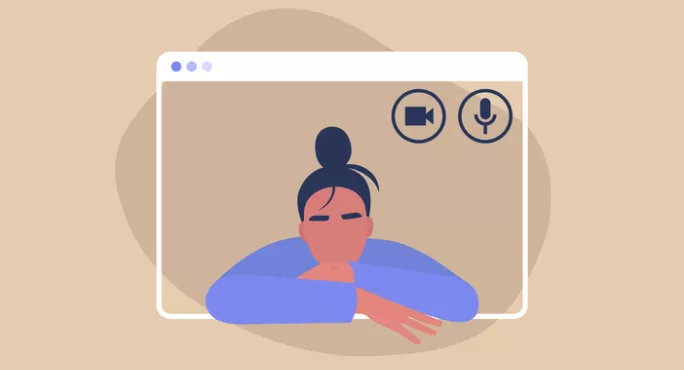Can online interaction ever equal face-to-face contact?

Nothing has changed more during the pandemic than our relationship with the built environment. Think how many fewer restaurants, pubs, shops, houses, theatres, cinemas and offices you’ve visited in the past year compared with any other.
There are many forecasters who think we won’t return to our old ways. Our familiarity with Teams and Zoom means we can work from home and avoid the rush hour. Home delivery has become mainstream. Why bother eating out when whole meals can come to you? Splash out your increased savings on an entertainment system and suddenly Netflix puts Cineworld in the shade, at least until James Bond finally feels safe enough to show himself on the red carpet.
These forecasts rely on the improvements in productivity we are seeing, especially improvements in economy and efficiency. Travelling from bedroom to study costs nothing in petrol, plus, in the time it takes to travel to work, you could have held another couple of meetings.
Need to know: Face masks to be worn in colleges until May
More: Why students should co-design courses
Blended learning: Eight things that students say work
But are we sure we will see improved effectiveness, too? Will we continue to do the right things? The pandemic chant of “work from home if you can” rather than “if it’s best” suggests that effectiveness has taken a back seat, at least temporarily.
Online learning versus face-to-face contact
One of the great privileges of being a college principal is the invitations to attend special built environments. I feel lucky to have seen Buckingham Palace, Downing Street, every London guild house, most Cambridge and Oxford colleges, all key government offices, the Speaker’s House, and attended events at the Lords and Commons. These venues are a key attraction in taking up an invite, and you know others feel the same, so you can be assured you will meet the people you want. So many great ideas come from those informal interactions in a way that you simply cannot achieve online, and most of those ideas are about effectiveness rather than efficiency.
The draw of a shared special event might take a day of your time for perhaps a few hours’ work, but if we don’t go back to this uneconomic approach, we will surely pay a price in terms of less innovation and learning. Sometimes you have to take the risk of wasting time for an unexpected nugget of wisdom that will pay back handsomely.
Similarly, spending significantly less time in the collective workplace might also exact a price. Most management manuals concerned with teamwork, or the effectiveness of organisations, are big on networking, on mobility and proximity. Think how many texts promote manager visibility as a key requirement of success. One of the most successful approaches of the past few decades has been management by wandering about (MBWA), something that is impossible to replicate online. We know that the team spirit inside large organisations is built on the myriad micro-interactions that occur every day.
The importance of building team spirit
I was once followed for a day and was surprised to learn that I said hello or exchanged a few words with over 250 individual staff members. The subsequent evaluation showed that it mattered to staff and helped cohesion. Someone once joked that to most of his fans Tom Cruise is simply a set of two-dimensional pixels and he didn’t need to actually exist. That might work for a film star but is it credible for a chief executive to not exist in the same way?
In his bestseller The Culture Code, Daniel Coyle highlights the importance of physical proximity and even touch to creating belonging. He cites the Allen curve, based on the finding that cohesion is primarily a factor of distance between desks. Interaction skyrockets once you get closer than six metres and staff even send each other more emails the closer they are seated. He argues for arranging furniture to keep people cramped around a table for team meetings. We see how sports teams and partnerships of all types routinely fist-bump, high-five, even hug as a means of celebrating every goal or point, or consoling after every mistake. Proximity and touch might be tricky in a time of Covid-distancing but it is hard to deny their importance. Will online clap icons and thumbs-up clicks of support build cohesion in the same way?
What The Culture Code shows is that teamwork is not just about mechanical connection. It is about a shared purpose and feeling safe enough to show vulnerability. Togetherness is about more than simply bringing people together. It is interesting that Microsoft chooses to call its product Teams, not Connections, recognising that the goal of the app is much more than simple accessibility. The test will be whether it can live up to its name.
So as we emerge from the isolation of lockdown, will the heralded new blend of home and campus work retain a focus on effectiveness as well as economy and efficiency? Perhaps we will discover new online ways to be effective. Perhaps the self-help shelves of your favourite bookshop will be filled with a new genre of management manual. Look out for those new bestsellers: Management by Staying Put, The Invisible Manager, The Screen Time of Your Life and Pixel Power: The Tom Cruise guide to making your mission possible.
Ian Pryce is principal and CEO of the Bedford College Group
You need a Tes subscription to read this article
Subscribe now to read this article and get other subscriber-only content:
- Unlimited access to all Tes magazine content
- Exclusive subscriber-only stories
- Award-winning email newsletters
Already a subscriber? Log in
You need a subscription to read this article
Subscribe now to read this article and get other subscriber-only content, including:
- Unlimited access to all Tes magazine content
- Exclusive subscriber-only stories
- Award-winning email newsletters